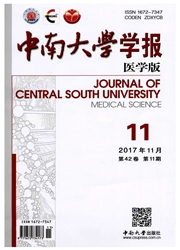

 中文摘要:
中文摘要:
目的 介绍一种豚鼠耳蜗内铅含量的检测方法。方法将10只成年豚鼠按数字随机法分成实验组及对照组(每组5只动物),实验组用含浓度为2mmol/L醋酸铅的纯净水喂养1个月,对照组用不含醋酸铅的纯净水喂养1个月。实验结束时用10%水含氯醛溶液麻醉豚鼠后采血2m1送检,并在显微镜下解剖出耳蜗基底膜及螺旋韧带并用65%-68%浓硝酸溶解,在原子吸收光谱仪中分别检测血铅及耳蜗组织中铅含量,然后对两组结果进行对比分析。结果实验组与对照组的血铅浓度分别为(73.26±12.06)、(5.53±1.25)μg/dL,实验组血铅浓度明显增高,与对照组比较其差异具有统计学意义(t=12.49,P〈0.001);实验组与对照组耳蜗内铅含量分别为(25.87±14.60)、(29.31±11.70)μg/g,两组之间比较差异无统计学意义(t=0.74,P〉0.05)。结论通过原子吸收光谱法检测豚鼠耳蜗内铅含量是一种简单有效的定量检测耳蜗内铅含量的方法。
 英文摘要:
英文摘要:
Objective To introduce a method for detection of lead concentration in guinea pig cochlea. Methods 10 adult guinea pigs with normal hearing were randomly divided into 2 groups ( control and experimental group, n = 5 ). They were fed 0 mmol/L or 2 mmol/L lead acetate water for one month, respectively. The blood and cochlear basal membrane as well as spiral ligament were harvested, and the cochlear tissues were dissolved in 65% to 68% nitric acid solution. After that, the lead concentrations of dissolved cochlear tissue and blood were measured by atomic absorption spectrophotometry. Results The blood tead concentrations of the control and the experimental groups were (5.53± 1. 25 ) μg/dL and ( 73.26±12.06 ) μg/dL respectively, and the difference was statistically significant ( P 〈 0. 001 ). The cochlear lead concentrations of both groups were (29.31 ± 11.70) μg/g and (25.87 ± 14.60 ) μg/g respectively, and the difference was statistically insignificant ( P 〉 0.05 ). Conclusion Detection of cochlear lead concentration by absorption spectrophotometry is a simple and useful quantitative assessment of lead concentration in cochlea.
 同期刊论文项目
同期刊论文项目
 同项目期刊论文
同项目期刊论文
 Effect of cetyltrimethylammonium bromide on morphology and porous structure of mesoporous hydroxyapa
Effect of cetyltrimethylammonium bromide on morphology and porous structure of mesoporous hydroxyapa 期刊信息
期刊信息
